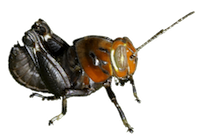| |
Family (Alpha): | |
| View | Acrididae Members:
| NC Records |
|---|
Melanoplus keeleri luridus (Dodge, 1876) - Broad-necked Locust |
 |  |
|
|
|
|
|
Image Gallery for Melanoplus keeleri luridus - Broad-necked Locust
|
 | Recorded by: Mark Basinger
Mitchell Co.
Comment: |  | Recorded by: Mark Basinger
Mitchell Co.
Comment: Red tibiae was distinct. |
 | Recorded by: Mark Basinger
Mitchell Co.
Comment: Red tibiae was distinct. |

 »
»


 »
»
